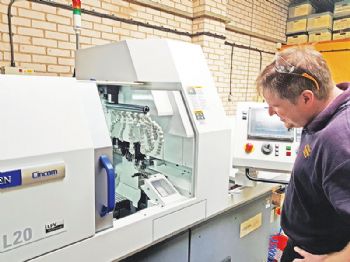
Astley Diamond Tools is a small business based in Witton, Birmingham, that recently made a significant investment
in the latest Low Frequency Vibration (LFV) turn-mill technology from Citizen Machinery UK; and within just three months of the machine being installed, proprietor Ben Astley not only transformed his firm’s blank-turning operations for its diamond tool production but also started providing a small-part turn-milling sub-contract service.
Mr Astley said: “Swarf problems totally controlled our machining of silver-steel blanks, which we electro-plate with diamond finishes and sell both direct to customers and through a world-wide network of distributors.”
The advantages of LFV technology on the Citizen Cincom L20-VIIILFV turn-mill centre from Bushey-based Citizen Machinery UK Ltd (
www.citizenmachinery.co.uk) were immediately apparent when recently machining a batch of 500 rotary diamond burrs for a regular Polish customer that uses them to fettle cast-iron components.
Mr Astley said he previously had to ‘stand guard’ over his ageing sliding-head machine and stop it about every five parts to clear the tangles of swarf.
“It would take at least 70hr to produce the batch, but I can complete the same order well within 16hr with LFV.
“Because swarf is now chipped so finely, the only attention required is to replenish the bar feeder and remove completed parts from the out-feed conveyor. Moreover, size and surface finish are totally consistent.
“This level of performance means that I can now concentrate on the electro-plating, packaging and other duties such as paperwork — and focus on providing customers with a sub-contract turning service.
“Customers that used to call in to collect parts, or give me an order for diamond tools or plating work, are now asking me to quote for a variety of new turning work — and giving me orders.
“I recently completed an order for hundreds of small collets made of EN24T. I turn the outer form and drill through; the customer then undertakes the slitting operations and finish grinding.”
LFV is based on choosing sequences (programmed at the machine control through ‘G-codes’) that dictate the size of chip that will be produced by introducing oscillations to the cutting tool through the servo axes of the drive system in the direction of feed.
This happens in phases of tens of microns that are precisely synchronised with the rotation of the machine spindle.
The resulting controlled ‘air-cutting’ breaks the swarf into a designated chip size that prevents ‘bird-nesting’ and can be applied to turning and drilling — and even threading cycles.
Furthermore, LFV can be switched in or out of the programmed cycle as required; it also helps to reduce the onset of built-up edge on the tool tip, extending its in-cut life.
LFV also allows greater depths of cut to be used — and it enhances surface quality via the wiping action of the tool.
Long-established operation
Astley Diamond Tools was set up by Mr Astley’s father, who retired two years ago. The firm produces tools between 3 and 20mm in diameter that are electro-plated with natural diamond, cubic boron nitride (CBN) and synthetic diamond.
The company also produces made-to-order internal grinding wheels between 3 and 20mm in diameter, routers for opening out gaskets and existing holes, diamond needle files, and electro-plated grinding wheels up to 450mm in diameter (the blanks for these are turned on another CNC lathe).

Turning silver-steel has always been a controlling factor in the tool production process.
In 2001, Astley Diamond Tools installed a used Citizen sliding-head lathe (16mm-capacity); this machine was a massive step forward for the company, and it became the ‘workhorse’ for blank production.
Recently, an increasing number of customers were asking for larger-diameter tools; and having seen articles explaining how LFV technology can enhance the cutting of difficult materials, Mr Astley sought more information on Citizen’s Web site, then went along to an Open House event last October.
“What really impressed me was the company’s understanding of my needs as a really small turning operation — and my concerns over the outlay and returns.
“Citizen staff spent time with me and put together a finance package specifically to suit my needs. That clinched the deal.”
Mr Astley says that while his firm is not an ‘out and out’ cycle time chaser (he tends to run the new machine at 3,000rev/min with feed rates of 0.35mm/rev), it is the ability to turn direct-to-depth in one cycle that is particularly beneficial.
“We use a lot of 20mm-diameter material and can run LFV with a 6mm depth of cut using standard carbide tooling —without a murmur from the machine, which is fitted with an IEMCA Elite 220S Superfast short-bar feeder due to limited space in our workshop.
“Another benefit of LFV chip control is that I was able to reduce the cost of the machine.
“For instance, we do not generate smoke during our machining cycles, so we didn’t need to buy a smoke hood; neither did we need high-pressure coolant — or even a new swarf bin.
“We are using our existing bins, because we can now precisely control the size of chips being produced, making swarf far easier to manage and bin emptying not such a regular occurrence.
“Moreover, because a lesser amount of coolant is required when using LFV, when I access the working area of the machine, I remain completely dry.”
Mr Astley also opted for Citizen’s Alkart CNC Wizard programming aid, which he says is absolutely “tailor made” for his needs, especially as he sometimes has to accommodate orders for just five tools.
“Most change-overs take 20-30min, with cycle times varying between 20sec for dowel type component to 65sec for a more-complex blank.”